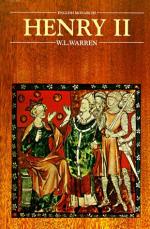cloth. The woad-sellers no longer heaped up their
measures, as of old, above the brim. The constables
on their side began to demand outrageous dues on the
sale of herrings, and what was more, whereas of old
heavy goods, such as wood, hides, iron, woad, were
sold outside the fair and escaped dues, now the constable
of the castle insisted on tolls for every sale even
without the bounds—a pound of pepper, or
even more, had to go into his hand. The citizens
of Lincoln had analized the Witham, and built up an
illustration of the rapid development of the trading
towns. As early as the beginning of the century
its owner, the Bishop of Norwich, had seen its advantages,
lying as it did at the mouth of the Ouse, and forming
the only outlet for the trade of seven shires.
It was not long before the prudent bishops had made
of it the Liverpool of medieval times. The Lynn
of older days, later known as “King’s Lynn,”
with its little crowded market shut in between Guildhall
and Church, the booths then as now leaning against
the church walls, and a tangle of narrow lanes leading
to the river-side, was in no way fit for the great
demands of an awakened commerce; its life went on
as of old, but the sea was driven back by a vast embankment,
and the “Bishop’s Lynn” rose on the
newly-won land along the river-bank, with its great
market-place, its church, its jewry, its merchant-houses,
and its guild-houses; and soon, in the thick of the
busiest quarter, by the wharves, rose the “stone
house” of the bishop himself, looking closely
out on the “strangers’ ships” that
made their way along the Ouse laden with provisions
and with merchandise.
But this growing wealth was still mainly confined
to the towns. The great bulk of the country was
purely agricultural, and had no concern in any questions
of trade. There is a record of over five hundred
pleas of the Gloucestershire fifty years later, and
among all these there is outside the town of
Gloucester but one case which deals with the lawful
width for weaving cloth, and one or two as to the sale
of bread, ale, or wine. The agricultural peasants
seem, from the glimpses which we catch here and there,
to have for the most part lived on the very verge
of starvation. Every few years with dreary regularity
we note the chronicler’s brief record of cattle-plague,
famine, pestilence. Half a century later we read
in legal records the tale of a hard winter and its
consequences—the dead bodies of the famine-stricken
serfs lying in the fields on every side, and the judges
of the King’s Court claiming from the starving
survivors the “murder-fine” ordained by
law to be paid for every dead body found when the
murderer was not produced. The system of cultivation
was ignorant and primitive. Rendered timid by
the repeated failure of crops, the poor people would
set aside a part of their land to sow together oats,
barley, and wheat, in the hope that whatever were the
season something would come up which might serve for




